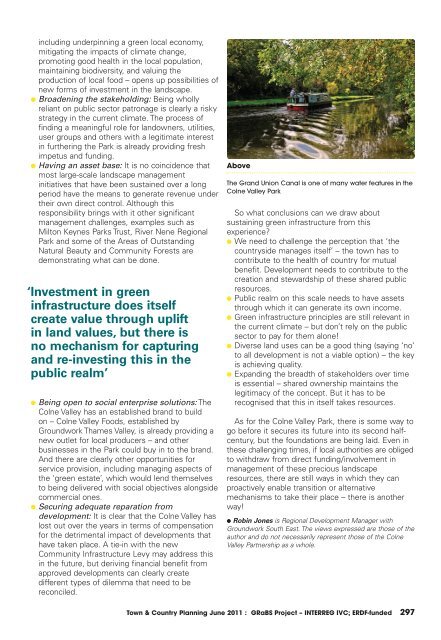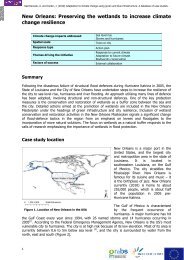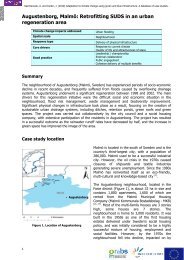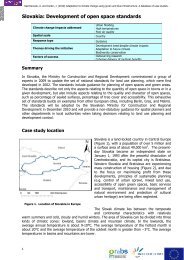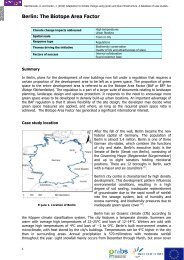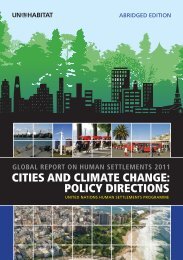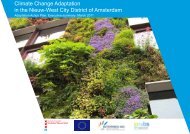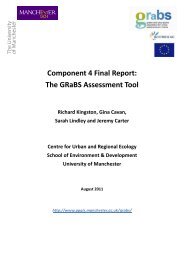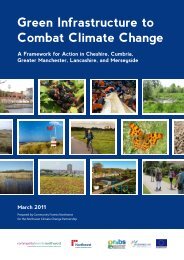Download - GRaBS
Download - GRaBS
Download - GRaBS
Create successful ePaper yourself
Turn your PDF publications into a flip-book with our unique Google optimized e-Paper software.
including underpinning a green local economy,<br />
mitigating the impacts of climate change,<br />
promoting good health in the local population,<br />
maintaining biodiversity, and valuing the<br />
production of local food – opens up possibilities of<br />
new forms of investment in the landscape.<br />
● Broadening the stakeholding: Being wholly<br />
reliant on public sector patronage is clearly a risky<br />
strategy in the current climate. The process of<br />
finding a meaningful role for landowners, utilities,<br />
user groups and others with a legitimate interest<br />
in furthering the Park is already providing fresh<br />
impetus and funding.<br />
● Having an asset base: It is no coincidence that<br />
most large-scale landscape management<br />
initiatives that have been sustained over a long<br />
period have the means to generate revenue under<br />
their own direct control. Although this<br />
responsibility brings with it other significant<br />
management challenges, examples such as<br />
Milton Keynes Parks Trust, River Nene Regional<br />
Park and some of the Areas of Outstanding<br />
Natural Beauty and Community Forests are<br />
demonstrating what can be done.<br />
‘Investment in green<br />
infrastructure does itself<br />
create value through uplift<br />
in land values, but there is<br />
no mechanism for capturing<br />
and re-investing this in the<br />
public realm’<br />
● Being open to social enterprise solutions: The<br />
Colne Valley has an established brand to build<br />
on – Colne Valley Foods, established by<br />
Groundwork Thames Valley, is already providing a<br />
new outlet for local producers – and other<br />
businesses in the Park could buy in to the brand.<br />
And there are clearly other opportunities for<br />
service provision, including managing aspects of<br />
the ‘green estate’, which would lend themselves<br />
to being delivered with social objectives alongside<br />
commercial ones.<br />
● Securing adequate reparation from<br />
development: It is clear that the Colne Valley has<br />
lost out over the years in terms of compensation<br />
for the detrimental impact of developments that<br />
have taken place. A tie-in with the new<br />
Community Infrastructure Levy may address this<br />
in the future, but deriving financial benefit from<br />
approved developments can clearly create<br />
different types of dilemma that need to be<br />
reconciled.<br />
Above<br />
The Grand Union Canal is one of many water features in the<br />
Colne Valley Park<br />
So what conclusions can we draw about<br />
sustaining green infrastructure from this<br />
experience?<br />
● We need to challenge the perception that ‘the<br />
countryside manages itself’ – the town has to<br />
contribute to the health of country for mutual<br />
benefit. Development needs to contribute to the<br />
creation and stewardship of these shared public<br />
resources.<br />
● Public realm on this scale needs to have assets<br />
through which it can generate its own income.<br />
● Green infrastructure principles are still relevant in<br />
the current climate – but don’t rely on the public<br />
sector to pay for them alone!<br />
● Diverse land uses can be a good thing (saying ‘no’<br />
to all development is not a viable option) – the key<br />
is achieving quality.<br />
● Expanding the breadth of stakeholders over time<br />
is essential – shared ownership maintains the<br />
legitimacy of the concept. But it has to be<br />
recognised that this in itself takes resources.<br />
As for the Colne Valley Park, there is some way to<br />
go before it secures its future into its second halfcentury,<br />
but the foundations are being laid. Even in<br />
these challenging times, if local authorities are obliged<br />
to withdraw from direct funding/involvement in<br />
management of these precious landscape<br />
resources, there are still ways in which they can<br />
proactively enable transition or alternative<br />
mechanisms to take their place – there is another<br />
way!<br />
● Robin Jones is Regional Development Manager with<br />
Groundwork South East. The views expressed are those of the<br />
author and do not necessarily represent those of the Colne<br />
Valley Partnership as a whole.<br />
Town & Country Planning June 2011 : <strong>GRaBS</strong> Project – INTERREG IVC; ERDF-funded 297


